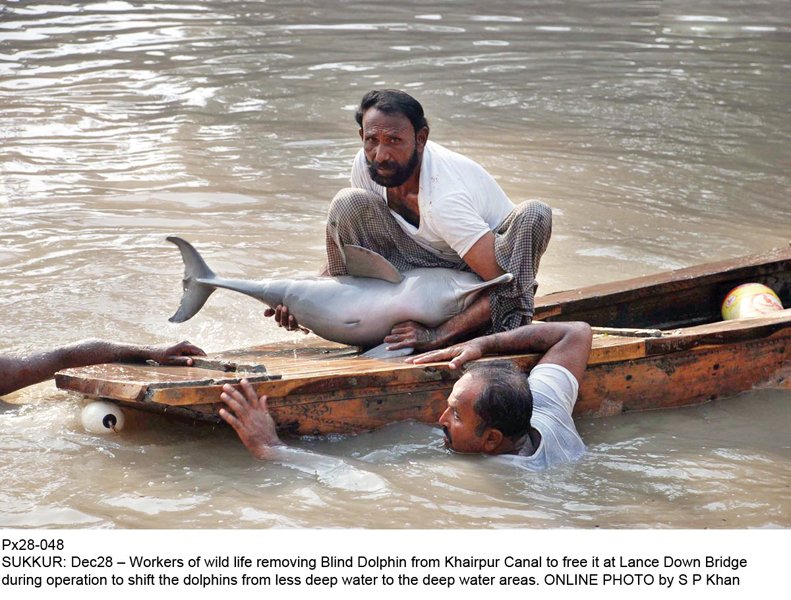
According to a survey conducted by the World Wide Fund for Nature (WWF) in 2011, only 1,452 blind Indus dolphins remain in the river. Out of these, 96 dolphins were found between Chashma and Taunsa barrages, 465 were found between Taunsa and Guddu barrages, 857 between Guddu and Sukkur barrages and 34 were found between Sukkur and Kotri barrages. According to the WWF, the surveys are conducted every five years.
Expert opinion
The pollution in the River Indus is affecting the dolphins along with the fishes and even human beings who eat these fish. The fishermen add poisonous chemicals into the water in order to catch more fish with ease.

Talking to The Express Tribune, Sukkur wildlife department deputy conservator Ghulam Muhammad Gadani said that only three dolphins were killed in 2013, while 30 were killed in 2012 - a majority of which were due to excessive fishing and dumping of poisonous chemicals. "This shows that our campaign to raise awareness is working," he said. "In the past, fishermen also used to dump poisonous chemicals into ponds that ended up in the Indus river. However, this year we have not had that problem."
Gadani added that the use of pesticide is also contributing to water pollution while lamenting that it is now considered commonplace to dump waste into the river. "Nobody observes environment protection laws anymore," he felt. "There needs to be strict implementation of these laws if we want to save endangered species from extinction. Dumping industrial and residential waste into the river has become habitual."
However, Gadani felt that rather than blaming the general population, the focus should be on educating them about the wildlife. "Our people kill animals like crocodiles, leopards and water otters. They need to be made aware about the fact that these animals are endangered and should therefore not be harmed."
Sukkur Dolphin Centre incharge Mir Akhtar Talpur told The Express Tribune that the natual habitat of the Indus dolphin is between the Jinnah Barrage near Kalabagh and the Kotri Barrage. "Excess fishing is posing a threat to all animals in the Indus River, including the Indus dolphin," he added. "The Indus dolphin is similar to another species that is found in South America, China and India. However, the Indus dolphin is set apart from them due to its blindness. The blind dolphin is found only in the River Indus."
Talpur then revealed that the dolphin breastfeeds its kids for three months before they are able to start hunting on their own.
"The total population of the dolphin in River Indus is increasing but the growth is very slow," he revealed. "The average age of a healthy Indus dolphin ranges from between 25 to 30 years. They are fragile mammals and often die of heart attacks. "
While talking about how the dolphin copes with being completely blind, Talpur said that it is blessed with a radar-like sonar system which it uses to hunt and navigate. "The Indus dolphin is a very friendly and harmless creature but it cannot be trained like other marine dolphins since it cannot see and therefore cannot follow the gestured instructions of dolphin trainers."
Published in The Express Tribune, February 11th, 2014.
COMMENTS (7)
Comments are moderated and generally will be posted if they are on-topic and not abusive.
For more information, please see our Comments FAQ










1732643921-0/4548774-1403918848-(1)1732643921-0-270x192.webp)






please don't kill poor dolphins. There should be effort to safeguard poior animal and don't pollute your rivers.
@AW: You are right! Only that human extinction should also be pointed at North, West & South West too... Not just South. As a mater of fact: Except the population of humans, no wild life or wilderness crucial to earth eco-system is spreading. Many wild plant & animal species that could be used for making medicine & human health are gone forever.
The only breed under threat in south of Pakistan is 'humans'. Dolphins will evolve.
Such a great news:)
But Dolphins are Dolphins :)
excellent news.
That's a priceless job being done. Thanks to Mr. Akhtar Talpur effort. I wonder if they being trapped between two dams can effect their growth of future in some way? They can't go to their breeding ground, neither can they hunt or eat all what they were doing before dams.